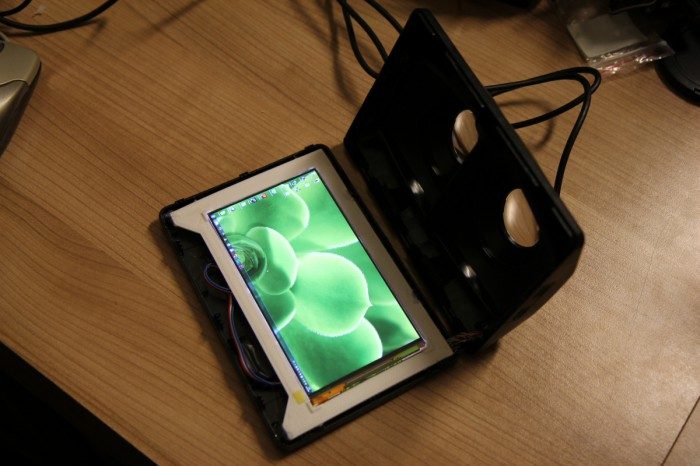“Hmmm, upgrades!”
The first Oculus Rift Developer Kit will hopefully be viewed fondly in retrospective articles of the future citing its, at the time, revolutionary impact on the gaming industry and it’s resurrection of a abandoned tech dream. One thing that’s unlikely to remembered fondly however, is the panel Oculus were forced to adopt in those DK1 units shipped to Kickstarter backers and early adopters. Owners know well the issues; motion blur, poor contrast and colour saturation, low resolution (1280×800) and pixel fill factor. It’s a testament to how great the DK1 package was as a whole that it was received so warmly.
So, almost since the day DK1’s started hitting backers’ doormats, people have longed for an upgrade, ideally one that you could apply with minimal fuss and no requirements for soldering or glue guns. Unfortunately, the construction of the rift and its control box makes such an upgrade challenging. Although the cable connecting the control box to the HMD isn’t hard-wired to the Rift, finding a panel and display control board that was compatible proved largely elusive for some time.

Now comes RiftUp!, a venture that claims to be able to offer just that from a company called Rozsnyo Cinema Devices. The group, formed mostly from MTBS3D forum members, claimed to have engineered what they call a “non invasive” and “drop in” solution for upgrading that low resolution panel in your DK1 to a 1080p unit. The solution essentially seems to replace all the key electronic components in the Rift with components designed to fit in the original housing. The idea being, you can just crack open the shell of the control box and the HMD itself and drop in the RiftUp! component replacements. That’s the theory at least.
For pledging $199 and up you get:
– 5.9″ display with protective foil
– Display interface board (goes into headset)
– Breakout board (goes into breakout box)
– Positioning frame (mechanical support of display)
Detailed information on the IGG campaign page itself is somewhat lacking, but it seems the team claim to have achieved 100% compatibility with the existing Oculus SDK and presumably that includes the HID drivers used to read information from the units tracking module via USB. It’s not clear however how the team can substantiate that claim given the large shift in the size and resolution of the panel. The original DK1 used a 7″ LCD panel, RiftUp! supply a 5.9″ unit. As the DK1 assembly was designed around that 7″ unit, lens distance from the board and the lenses themselves were crafted to provide the optimal field of view with those parameters. Anyone who has used Oculus’ HD prototype, which used a 5.5″ 1080p panel, will recall that the FOV was clipped at left and right of the image, a direct result of retrofitting a smaller panel to what was essentially a DK1.

The team emailed Road to VR yesterday and made clear that in order to compensate for the smaller panel, users would have to move to the C-cup lenses shipped with the developer kit. Those lenses were designed for use by those with vision problems (nearsightedness), and would require the use of glasses in daily life. As such, they presented a compromise in FOV versus clarity. They were also designed to be used with the 7″ panel based on the dimensions of the DK1 chassis. As such, profiles were built into the Oculus SDK to provide the correct correction for chromatic aberration caused by the powerful, aspheric lenses used in the Rift. The team claim to provide a custom profile the provides correct compensation for the differences in panel size and use of the C-cup lenses. This however seems to me to be a tricky thing to get right and as yet there is no one out there who can independently verify how successful this approach is. Problems with IPD and therefore scale would also potentially be a challenge according to one of our technical sources.
So, it’s an interesting project for sure and one that addresses a need long present for those owning DK1s waiting for the next publicly available prototype. But I’m not sure, given the recent announcement and commencement of pre-orders for the new Developer Kit V2 (DK2) which is slated to ship to users in July, that the outlay required represents value for money when the DK2 will be superior in almost every way. That’s not limited to the low persistence of vision technology and the 1080p OLED panel either. Those that have used the DK2, including our own Ben Lang, claim that improvements in optics and comfort mean that the DK2 is a world away from its predecessor in all respects.
RiftUp! does offer a quick solution for those desperate to get more resolution out of their old DK1s for sure and the team claim they’ll be able to manufacture within 3-4 weeks after the campaign’s conclusion and have the upgrades to backers around 3 months ahead of the first DK2s hitting users doorsteps, so those curious should check it out, but be aware that there may be limitations and side effects of the upgrade that we are as yet unaware of.
We’ll try to get answers to our concerns from the RiftUp! team and report back with what we find. In the mean time, you can find the IndieGogo campaign page here.








